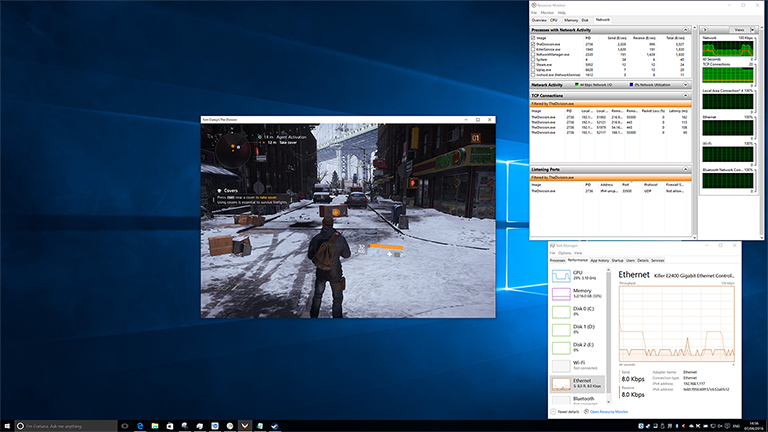Prioritisation Is Key
The benchmarks thus far have told us an inevitable truth, in terms of throughput and bandwidth, it isn't easy to distinguish between Killer solutions and other high-end alternatives using simple synthetic tests.
Killer's wired and wireless solutions do have added extras that enhance performance - DoubleShot Pro and MU-MIMO being prime examples - yet throughput alone isn't the name of the game. Neither is latency. We could run round-robin tests and send a byte of data between devices, and doing so would reveal that Killer has an advantage when it comes to keeping latency to an absolute minimum.
However it's the real-world implication that matters, and what we need to see is the benefit of combining high throughput, low latency and intelligent prioritisation via Advance Stream Detect. It's a benefit that does exist, so let us demonstrate.
The Division: low-latency online gaming as it should be
The above screenshot shows us playing The Division on a Core i5/GTX970M laptop. The game is being played in a window to allow us to see latency via Resource Monitor, and the laptop is connected to the web via a Killer E2400 Gigabit Ethernet port. Everything is as it should be - the game is running smooth with latency at 65ms.
Gaming in a traffic jam is no fun
Here's a scenario we should all be familiar with. A Steam game is now downloading in the background, and we're also attempting to play a 1080p video via YouTube. The Steam download is flying, but with Advance Stream Detect disabled, the E2400 is behaving like any other network controller and treating all data packets the same, with no prioritisation.
As a result, the YouTube video struggles to get past buffering and the game begins to stutter quite badly, with latency effectively doubled, to well over 100ms.
Advance Stream Detect to the rescue
Repeating the above example with Advance Stream Detect enabled via the Killer Network Manager utility reveals a genuine improvement. The E2400 is now able to recognise and prioritise network traffic associated with the browser-based video and online game, resulting in buffer-free playback on YouTube and vastly improved latency in The Division.
The benefits of network prioritisation are clear to see, yet this example does raise a few other question marks. How many users actually watch videos and start large downloads while they're gaming on the same device?
And while Killer's tech helps keep things smooth on the device in question, it isn't going to count for a lot if another device on the same network starts hogging your broadband. Advance Stream Detect is good, but not good enough to stop the kids downloading full-HD SpongeBob episodes on their iPad while you're playing your favourite FPS. This is where optimisations baked into a router come into play.












